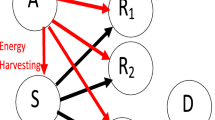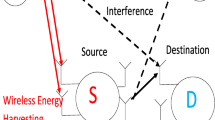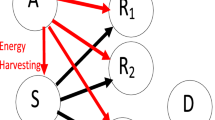Abstract
In this paper, we optimize the throughput of cognitive radio networks (CRN) when all secondary nodes harvest energy from radio frequency signal received from primary transmitter (\(P_T\)). These secondary nodes are equipped with multiple antennas and adapt their power so that the interference at primary receiver \(P_R\) is less than interference threshold I. Our results are valid for cooperative CRN with opportunistic amplify and forward, partial and reactive relay selection. We also choose an appropriate value of harvesting duration to enhance the throughput at secondary destination.










Similar content being viewed by others
References
Amini MR, Mahdavi M, Omidi MJ (2018) Discrete-Time Markov Chain Analysis of Energy Efficiency in a CR Network Regarding Primary and Secondary Traffic With Primary User Returns. IEEE Access 6:22305–22323
Amini MR, Mahdavi M, Omidi MJ (2019) Maximizing dynamic access energy efficiency in multiuser CRNs with primary user return. IEEE Syst J 13(2):1702–1713
Haykin S (2005) Cognitive radio: brain-empowered wireless communications. IEEE J Sel Areas Commun 23(2):201–220
Ibrahim NS, Sali A, Mohamad MH, Hashim SJ (2015) Outage performance in relay-assisted overlay cognitive radio networks. IEEE 12th Malaysia international conference on communications (MICC)
Jun Z, Yong L, Xiaohu T, Qingchun C (2018) Relaying protocols for buffer-aided energy harvesting wireless cooperative networks. IET Networks 7(3):109–118
Xiuping W, Feng Y, Tian Z (2018) The DF-AF Selection Relay Transmission Based on Energy Harvesting. In 10th international conference on measuring technology and mechatronics automation (ICMTMA), pp 174–177
Nguyen HT, Nguyen SQ, Hwang W-J (2018) Outage probability of energy harvesting relay systems under unreliable backhaul connections. 2nd International conference on recent advances in signal processing, telecommunications and computing (SigTelCom), pp 19–23
Chengrun Q, Yang H, Yan C (2018) Lyapunov optimized cooperative communications with stochastic energy harvesting relay. IEEE Int Things J 5(2):1323–1333
Dan S, Fengye H, Wei Z, Meiqi S, Minghui C (2018) Relay selection for radio frequency energy-harvesting wireless body area network with buffer. IEEE Int Things J 5(2):1100–1107
Dung LT, Hoang TM, Tan NT, Choi S-G (2018) Analysis of partial relay selection in NOMA systems with RF energy harvesting. In: 2nd International conference on recent advances in signal processing, telecommunications and computing (SigTelCom), pp 13–18
Kalluri T, Peer M, Bohara VA, da Costa DB, Dias US (2018) Cooperative spectrum sharing-based relaying protocols with wireless energy harvesting cognitive user. IET Commun 12(7):838–847
Dongqing X, Xiazhi L, Xianfu L, Lisheng F (2018) Cognitive multiuser energy harvesting decode-and-forward relaying system with direct links. IEEE Access 6:5596–5606
Zhi Y, Shuang C, Xing Z, Hong-Li L (2018) Outage performance analysis of wireless energy harvesting relay-assisted random underlay cognitive networks. IEEE Int Things J 5(4):2691–2699
Nhat LQ, Quoc BVN, Beongku A (2018) Full-duplex distributed switch-and-stay energy harvesting selection relaying networks with imperfect CSI: Design and outage analysis. J Commun Netw 20(1):29–46
Jie G, Xiang C, Minghua X (2018) Transmission optimization for hybrid half/full-duplex relay with energy harvesting. IEEE Trans Wireless Commun 17(5):3046–3058
Tang H, Xie X, Chen J (2018) X-duplex relay with self-interference signal energy harvesting and its hybrid mode selection method. In: 27th wireless and optical communication conference (WOCC)
Chiu H-C, Huang W-J (2018) Precoding design in two-way cooperative system with energy harvesting relay. In: 27th Wireless and optical communication conference (WOCC)
Gurjar DS, Singh U, Upadhyay PK (2018) Energy harvesting in hybrid two-way relaying with direct link under Nakagami-m fading. In: IEEE wireless communications and networking conference (WCNC)
Keshav S, Meng-Lin K, Jia-Chin L, Tharmalingam R (2018) Toward optimal power control and transfer for energy harvesting amplify-and-forward relay networks. IEEE Trans Wireless Commun 17(8):4971–4986
Yuan W, Li Q, Huang L, Shen X (2018) Optimal relay selection and power control for energy-harvesting wireless relay networks. IEEE Trans Green Commun Netw 2(2):471–481
Rongfei F, Saman A, Wen C, Yihao Z, Jamie E (2018) Throughput maximization for multi-hop decode-and-forward relay network with wireless energy harvesting. IEEE Access 6:24582–24595
Yuzhen H, Jinlong W, Ping Z, Qihui W (2018) Performance analysis of energy harvesting multi-antenna relay networks with different antenna selection schemes. IEEE Access 6:5654–5665
Mohammadreza B, Umit A, Ertugrul B (2018) BER analysis of dual-hop relaying with energy harvesting in nakagami-m fading channel. IEEE Trans Wireless Commun 17(7):4352–4361
Nhat TT, Duy TT, Bao VNQ (2018) Performance evaluation of cooperative relay networks with one full-energy relay and one energy harvesting relay. In: 2nd International conference on recent advances in signal processing, telecommunications and computing (SigTelCom), pp 7–12
Van Nhan V, Gia NT, Chakchai S-I, Ahmed BZ, Surasak S (2018) Secrecy outage performance analysis for energy harvesting sensor networks with a jammer using relay selection strategy. IEEE Access 6:23406–23419
Rugui Y, Yanan L, Tsiftsis Theodoros A, Nan Q, Tamer M, Fei X (2018) Secrecy rate-optimum energy splitting for an untrusted and energy harvesting relay network. IEEE Access 6:19238–19246
Cheng Y, Nguyen Huy T, Chinmoy K, Zeeshan K, Emiliano G-P, Duong Trung Q (2018) Secure energy harvesting relay networks with unreliable backhaul connections. IEEE Access 6:12074–12084
Hongjiang L, Ming X, Shafique AI, Gaofeng P, Qaraqe Khalid A, Mohamed-Slim A (2018) On secure underlay MIMO cognitive radio networks with energy harvesting and transmit antenna selection. IEEE Trans Green Commun Netw 1(2):2400–2473
Proakis J (2007) Digital communications, 5th edn. Mac Graw-Hill, New York
Gradshteyn IS, Ryzhik IM (1994) Table of integrals, series and products, 5th edn. San Diego, CA, Academic
Hasna MO, Alouini MS (2004) Harmonic mean and end-to-end performance of transmission systems with relays. IEEE Trans Commun 52(1):130–135
Krikidis I, Thompson J, McLaughlin S, Goertz N (2008) Amplify-and-forward with partial relay selection. IEEE Commun Lett 12(4):237–238
Boujemaa H (2010) Exact symbol error probability of cooperative systems with partial relay selection. Eur Trans Telecom 21(79–85):2010
Hussain SI, Alouini MS, Qaraqe K, Hasna M (2012) Reactive relay selection in underlay cognitive networks with fixed gain relays. In: 2012 IEEE international conference on communications (ICC), pp 1784–1788. IEEE
Xi Y, Burr A, Wei JB, Grace D (2011) A general upper bound to evaluate packet error rate over quasi-static fading channels. IEEE Trans Wireless Commun 10(5):1373–1377
Boyd S (2004) Convex optimization. Cambridge University Press, Cambridge
Author information
Authors and Affiliations
Corresponding author
Ethics declarations
Conflict of interest
The authors confirm that there is no conflict of interest for this journal paper.
Appendices
Appendix A: CDF of SINR Between i-th Transmit Antenna of \(R_k\) and j-th Receive Antenna of D
We have
Let \(Z=N_{0}+E_{P_{T}}|h_{P_{T},D}^{(j)}|^{2}\), we deduce
For Rayleigh fading channels, \(E_{P_{T}}|h_{P_{T},D}^{(j)}|^{2}\) follows an exponential distribution with mean \(E_{P_T}\beta _{P_T,D}^{(j)}\) where \(\beta _{P_T,D}^{(j)}=E(|h_{P_{T},D}^{(j)}|^{2})\). Therefore, we have
Using (22), we deduce
We use Gradshteyn and Ryzhik (1994) (6.631.3)
where \(W_{e,d}(x)\) is the Whittaker function Gradshteyn and Ryzhik (1994).
Using (58), (59) and (60), we have
where two integrals are evaluated numerically using MATLAB.
Appendix B: Probability to Select Relay \(R_k\) using PRS
For PRS, the probability to select relay \(R_{k}\) is expressed as follows
Let \(X=\max _{j\ne k}\Gamma _{SR_{j}},\) we can write
If \(\Gamma _{SR_{p}}\) are independent, we have
The PDF of X is written as
Appendix C: Probability to Select Relay \(R_k\) using RRS
For RRS, the probability to select relay \(R_{k}\) is expressed as follows
Let \(Y=\max _{j\ne k}\Gamma _{R_{j}D},\) we can write
If \(\Gamma _{R_{p}D}\) are independent, we have
We deduce
Rights and permissions
About this article
Cite this article
Ben Halima, N., Boujemâa, H. Energy Harvesting for MIMO Dual-Hop Cognitive Radio Networks. Iran J Sci Technol Trans Electr Eng 45, 1179–1190 (2021). https://doi.org/10.1007/s40998-021-00435-8
Received:
Accepted:
Published:
Issue Date:
DOI: https://doi.org/10.1007/s40998-021-00435-8




